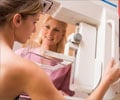Use of magnetic resonance imaging (MRI) plus X-ray mammography for screening will detect more breast cancers than mammography alone, for women at high risk of breast cancer.
Use of magnetic resonance imaging (MRI) plus X-ray mammography for screening will detect more breast cancers than mammography alone, for women at high risk of breast cancer. But the number of false positives —indicating a problem where none exists — will rise significantly also.
MRI is an imaging procedure that uses a magnetic field and pulses of radio wave energy to make images of organs and structures inside the body. The report aimed to determine whether the combination of MRI and mammography was more accurate than mammography alone in finding breast cancer.The TARGET™ emerging technology evidence report is published by ECRI Institute, an independent nonprofit health services research agency that researches the best approaches to improving patient care. The institute produces systematic reviews on medical devices, drugs, biotechnologies, procedures and health services.
Lead author Wendy Bruening, a senior research analyst at ECRI Institute, said she was not surprised that her analysis of the evidence showed that MRI detected more cases of cancer than X-ray mammography.
These findings, in fact, are consistent with the current guidelines of leading cancer organizations, such as the American Cancer Institute and the American Society of Breast Disease, that recommend screening that includes MRI, X-ray mammography and ultrasound for patients at high risk of breast cancer.
According to the National Cancer Institute, breast cancer is the most frequent newly diagnosed non-skin cancer in women in the U.S., and the second leading cause of cancer-related death. In 2007, an estimated 178,480 women will be diagnosed with breast cancer and an estimated 40,460 women will die of the disease.
While the causes of breast cancer are unknown, heredity has been identified as one risk factor. The authors write that about 50 percent of breast cancers associated with genetic risk factors are linked to a mutation of the BRCA1 or BRCA2 genes.
Advertisement
For the report, the authors analyzed data from six studies that screened a total of 1,920 women thought to be at very high risk of breast cancer due to their family history. The average age of these women ranged from 38 to 46 and they were estimated to have a 30 percent or higher risk of developing breast cancer in their lifetime.
Advertisement
The authors’ analysis found that when MRI was combined with X-ray mammography, more breast cancers were detected. Using both methods made it 2.7 times more likely to find true positives than using X-ray alone. Also, when women were screened with only MRI, the procedure was still more accurate in finding cancers than when only mammography was done — making it 2.3 times more likely to find true positives.
The report also found, however, that while screening with MRI plus X-ray mammography finds more cancers, it also leads to more false-positive results. Adding MRI to the screening program will lead to more women undergoing unnecessary follow-up procedures.
ECRI Institute’s analysis suggests that for every 10 additional cancers detected by MRI, an additional 16 false positives will occur. Bruening said, however, in this high-risk population, a higher rate of false positives may be considered acceptable.
“These women at high risk may be willing to go through additional unnecessary testing just to get reassurance that they do not have cancer,” Bruening said. “In high-risk women, the cancer can be more aggressive, so you want to detect it as soon as possible.
Whenever you increase the cancer detection rate you have to expect some additional false positives. But for women at high risk of cancer, the benefit of finding more cancers earlier may outweigh the harms of unnecessary testing.”
Carol Lee, M.D., chair of the Commission on Breast Imaging at the American College of Radiology, reviewed Bruening’s results and said the organization also endorses the American Cancer Society's recommendation that screening MRI be performed on women at very high risk for breast cancer, including those with BRCA1 or BRCA2 mutations.
“This screening should be in addition to, not in place of regular mammography,” Lee said. “Although it has not yet been shown that mortality from breast cancer is reduced by the addition of MRI to mammography for screening the high risk population, a growing body of evidence [like this study] demonstrates that MRI can detect cancers in these women that are not detected by mammography or physical examination.
Also, there are some cancers that are visible on mammography and not on MRI, so mammography should not be abandoned.”
Source-Eurekalert
JAY/M











